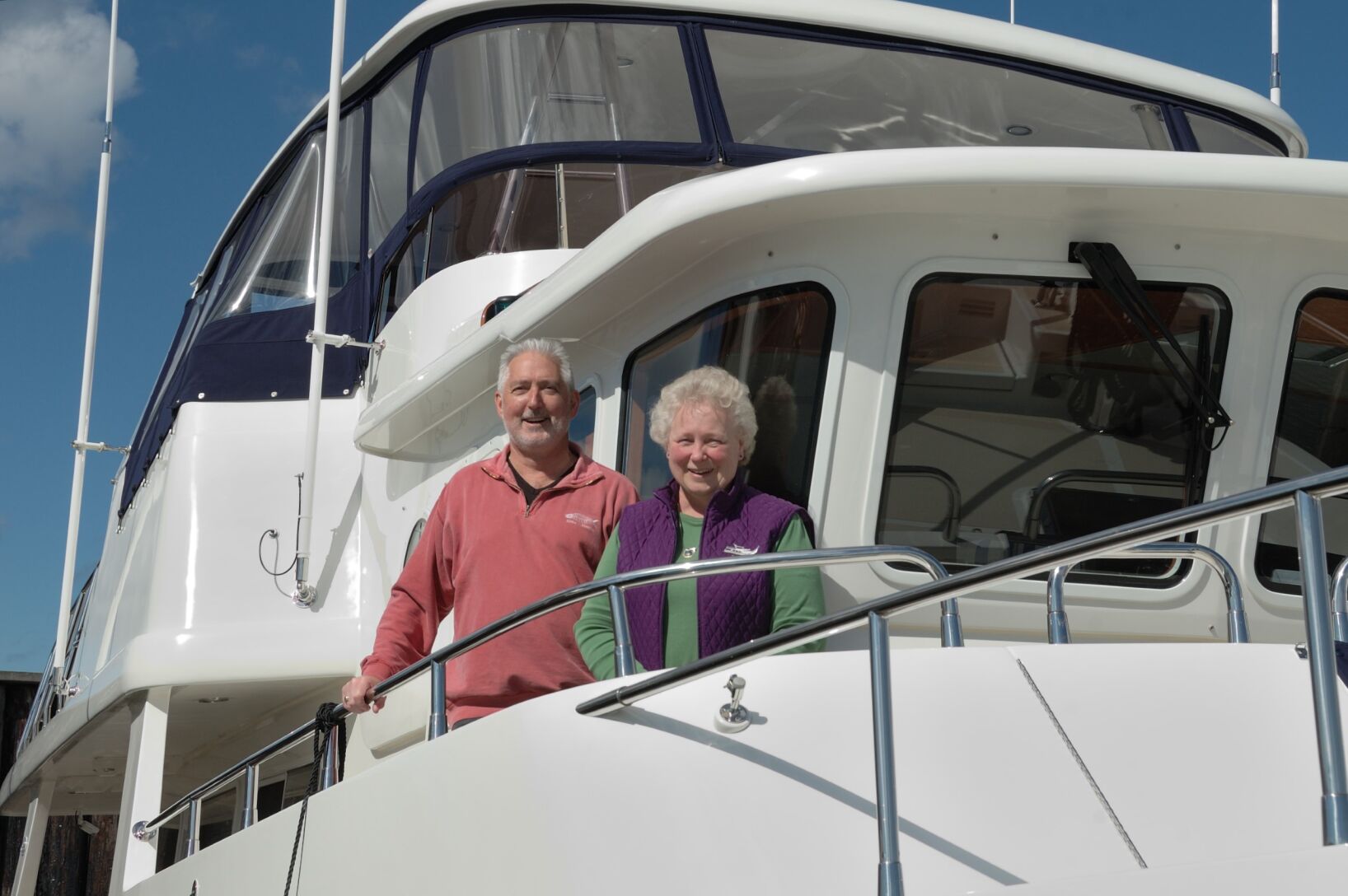It’s been said “living on a boat with your partner is similar to living in a closet together.” There is some truth to the statement. Few things will test a relationship faster than being in a small, confined space together. It makes little difference whether the boat is 25 feet or 50 feet, closeness can be an asset or a liability when it comes to a couple’s compatibility. One thing is certain, no boat is big enough for two when there is unresolved conflict. But when both people are working toward a common goal, that of enjoying the freedom of the boating life, it doesn’t get much better!
As fun, romantic and adventurous as boating can be, make no mistake, a boat is a third party in the relationship. It can—and often does—drive a wedge between two people. While some of the best memories you can create in your relationship can be aboard a boat, the opposite can be equally as true.
So, what’s the secret to keeping your boat and your relationship happily afloat?
Arlene and I are now in our 25th year of boating together, and cruising the coastline of beautiful British Columbia is one of our shared pleasures in life. We have owned three boats, from our original 28-footer to our current 40-footer, spent more than a combined 1,700 days on board and travelled way too many miles to count. During these times, we have established what you might call rules to keep Easy Goin’ and our relationship going strong. I can’t imagine boating without my wife. We’re having a terrific time and we plan to keep it that way.
Rule #1: Don’t Yell
Communication is key and yelling from the helm, “I said throw the line!” is not communicating. Being yelled at can be embarrassing for your partner. It’s equally embarrassing for the wharfinger to be standing on the dock while a couple is screaming at each other rather than simply tossing the line.
True communication involves understanding each other’s needs and setting expectations. Communicate the plan before carrying it out and make sure both partners are on the same page (see Rule #3). Then, during the procedure take your time and stay calm. As changes arise, explain things clearly in a normal speaking voice.
We have found wireless headsets to be helpful in maintaining respectful communications. With one of us at the helm and the other tending line we don’t always have a direct line of sight and it’s difficult to communicate without yelling. The headset makes it look like we are pros when we are docking and anchoring.
This rule is thrown overboard if someone goes overboard or if you’re in danger of hitting something, then yell away.
Rule #2: Don’t Dismiss Fears
Respect your partner’s fears and don’t minimize them. Head for port immediately when sea conditions make either individual uncomfortable. If there is a concern about travelling in the fog or at night or in heavy winds, then don’t do it. Do not minimize or argue the concerns away. Instead of dismissing your partner’s fears you can work to overcome them by taking boating classes together and then practicing what you learned to enhance your skills and confidence. Practice makes perfect (see Rule #4).
Rule #3: Communicate and Plan Together
People are wired differently. Some people like to plan and communicate the plan. While others, take me for example, prefer to make it up as they go. Both parties need to be involved in the planning of the trip or day, including making alternative plans.
Talk through the processes like docking and anchoring without an argument. Ask yourself if you are imparting information or instruction when you’re communicating and listen to what the other is saying.
Most long-term relationships that fail at sea are the result of the skipper mistakenly believing that their crew thinks just like they do. Make mutual choices that ensure each partner is comfortable with the decision. Each individual has veto power, and it’s OK to say, “My half of the boat is not going there.” There is no need to act like Captain Ahab. Decision making should not involve a power struggle, or a winner and loser. When there is a real imbalance in the decision making aboard, then decisions aren’t made with representation, and stress is the result—potentially the kind of stress that can end a cruise. When both parties participate in the planning, they can share responsibility for how things go.
Whether it’s anchoring or weighing anchor, tying up or leaving a dock, responsibilities are shared by the team. Each task should be discussed and decided beforehand, and any potential miscommunications ironed out. Then surprise is no surprise at all.
In our relationship we swiftly resolve our disagreements. When they are resolved, they don’t come back in a snarky, “I told you so,” three months later. This is the most important tip I can provide. It kept us from throwing each other off the boat during our extended cruises up the coast.
Take some time to communicate. Spending hours alone together is a great opportunity to have a two-way conversation. Playing board games and cards while on the water can be a nice way to relieve tension and build a closer relationship. Share your hopes, beliefs and dreams.

Rule #4: Establish Trust
Couples who are successful boaters have developed a high degree of mutual trust. This does not come automatically, but only after training, teamwork, practice and time. To develop trust, the importance of training can’t be overemphasized. Canadian Power and Sail Squadrons, among others, offer a selection of boating safety, vessel handling and navigation courses in a classroom environment and online. There are also courses available on boat handling for couples. If you take one of these courses together, you not only learn to boat, but you’ll discover your partner’s capabilities. It’s one thing to gain that knowledge yourself, but when your partner has that knowledge and confidence as well, a degree of mutual trust is gained. It may be beneficial for some couples to take courses separately as well.
Rule #5: It’s a Team Effort
The key to owning and operating a boat is teamwork. If one person is usually the skipper and the other the first mate, they should swap occasionally. Nothing will make the first mate enjoy their outing more than seeing the skipper frantically tying lines and fenders while they calmly direct from behind the wheel.
It’s collaboration that makes boating work. Everyone needs to practise docking and anchoring in order to be proficient. In far too many boating relationships I’ve seen, the female is relegated to mate or perhaps doesn’t want to participate in operating the boat. However, each partner should know how to set the anchor, drive, use the electronics, chart a course and operate the dinghy. That doesn’t mean that both partners have to be equally good in the same things, but both need to be capable of handling the boat, in case something happens in the middle of nowhere. If the first mate becomes proficient in the operation of the boat, I can guarantee they will feel more confident while on board. It’s the aggregate of the parts that establishes the strength of the team.
Along with this, both parties should participate in the planning of your cruising and purchasing of equipment and boat décor. It’s called co-ownership.
Rule #6: Have a Plan for Docking
How many times have you wondered whether the couple on the boat coming into the marina would be docking or divorcing first? Sometimes I believe they are ready to call the attorney before they hail the harbourmaster for their docking assignment.
Docking a boat together can be a very stressful activity for boating couples. Many of us have seen the results when it doesn’t go well. One party disappears below, or they exchange a few choice, loudly spoken words. While it can be entertaining to observe once you are safely docked, it’s best not to be the entertainment.
Discuss in advance the best way to arrive safely at the dock. Make sure both parties clearly understand their roles and remember, no yelling. Should there be a problem, no matter what happens, don’t blame each other in front of others. Public humiliation is never a good thing.
Rule #6, Subsection A: Aboard Easy Goin’ there is no jumping. Far too many boaters are hurt jumping to the dock; besides we’re getting too old to be leaving our feet! If you aren’t in position on the first pass, circle around and try again.
Rule #7: Share the Chores
Men, don’t expect your partner to prepare three course meals, do dishes, clean the inside of the boat, provision and do laundry. Divide the chores and help out in all aspects of the cruising experience. This will go a long way in keeping peace on board. We have a rule that when in port we go out to eat, thereby letting someone else do the cooking and wash the dishes. At this point I do have to admit that Arlene enjoys preparing meals on board and does a wonderful job. Although I’m the master of the barbecue. Find what works for you, but don’t be afraid to change it up. Teamwork!
Rule #8: Respect Each Other’s Space
On extended cruises into the wilderness, couples can be trapped together on the boat at anchor for days while they ride out a storm waiting for a weather window. There’s often no TV or internet to escape to, nor any other outside stimulation.
Living in a small space, it’s difficult to sneak away like you can in a house. Couples can provide each other physical privacy, but it’s important to respect the other’s mental space with “virtual” privacy, courtesies familiar to any cubicle dweller. If your partner is reading or writing, avoid making conversation. We all need a mental break from each other from time to time.
Rule #9: Have Fun
Sometimes it’s easy to become so focused on the operational aspect of the journey that the atmosphere on board can become tense. Find times during the day to relax and have fun. You don’t have to laugh your way through the entire cruise, but lighten up, chances are you both will enjoy the time together more.






